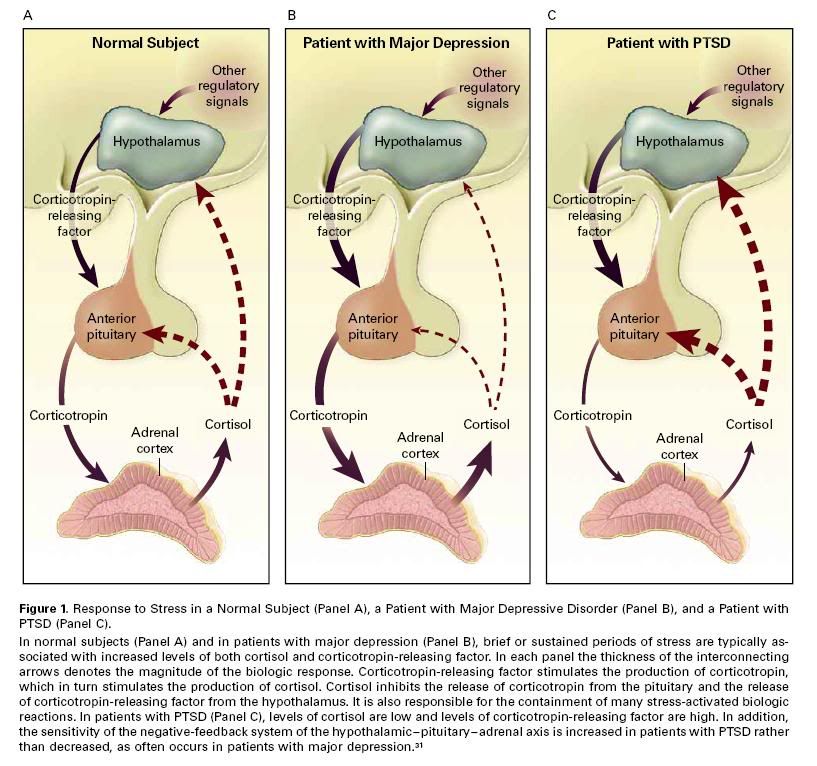PTSD

Post-Traumatic Stress Disorder
Post-Traumatic Stress Disorder (PTSD) is the condition a person experiences when trauma-related symptoms or impairments in everyday functioning last for extended periods of time. It has been recognized by many other names since the late 1800s (e.g. shell-shocked, combat fatigue, “war neurosis” syndrome, etc.) and was not defined as a distinct prognosis by the American Psychiatric Association until 1980. Trauma, the necessary precursor for PTSD, as cited in the Diagnostic and Statistical Manual of Mental Disorders can include assault, rape, torture, imprisonment in a death camp, military combat, natural disasters, industrial accidents, or exposure to war/civil/domestic violence.
Historical Overview
Medical attention began to focus on the psychological impact of military combat in the late 19th century among veterans returning home from the U.S. Civil War and the Franco-Prussian War. Clinicians first noted the psychological and cardiovascular symptoms of what would later be named PTSD. American psychiatrist, Abram Kardiner who worked at length with World War I veterans was so impressed by his patients’ reactions that he called it “physioneurosis.” Since then, millions of Americans have suffered from PTSD even though the disorder was not officially recognized until 1980 before which it was often overlooked and under diagnosed.
In the context of the Vietnam War, on April 26, 1979, several years after veterans began coming home, the Senate Veterans Affairs Committee gave the formal authorization for the Veterans Administration to recognize and treat PTSD. Before its approval, legislation had been proposed and denied several times because the U.S. House and Senate were reluctant to spend the money that would be required for treatment for veterans. In 1979, Congress set aside only $9.9 million of $2.3 billion for peer group counseling to be set up. Some even criticized the recognition of PTSD as an anti-war movement or people looking for a way to get money from the Veterans Administration.
Main Characteristics of PTSD
The main characteristics of PTSD can be categorized into three types – reexperiencing, avoidant/numbing, and hyperarousal. Reexperiencing symptoms often relate to or reflect events of the trauma. They are intrusive because they are often strong enough to negate thoughts of or concentration on anything else. These recollections can occur in the daytime or in the form of nightmares. Also known as a brief psychotic state, flashbacks in which PTSD victims relive the traumatic experience, losing all connection with the present often occurs. Avoidant symptoms often manifest themselves in behavioral or emotional defense mechanisms to evade distress. Symptoms will include attempts to avoid associations with the traumatic event or inability to remember the traumatic event altogether. Numbing symptoms also occur when a person suppresses all feelings in order to block the feelings that resulted from the traumatic one. Finally, hyperarousal symptoms are the most evident effects of PTSD. It often includes insomnia, irritability, exaggerated responses to unexpected noises or movements, and hypervigilance. These symptoms often result in a state, which makes it difficult for people with PTSD to perform everyday tasks.
In most cases, people who suffer from PTSD can lead fulfilling lives despite the effects of their traumatic experiences. In only extreme cases, people may develop severe intolerable symptoms in which treatment is required in order for them to become functional members of society. 









Psychological Treatments for PTSD
Psychological treatment for PTSD commonly begins with psychoeducation in which is designed to help a patient understand PTSD in its entirety and how it impacts their lives. This is often followed by individual psychotherapy to treat specific symptoms. One example of individual psychotherapy is to evoke the post-traumatic emotional response an effort to reduce its intensity. Finally, group therapy is often used for people who have experienced similar types of trauma. It allows group members to connect to one another and develop coping strategies or derive meaning from the traumatic experience.
Preventing PTSD
Unfortunately, there is no proven method for preventing PTSD as traumatic events are unpredictable. People differ in vulnerability to or resilience against post-traumatic stress. It has been proven however, that those who are involved in strong support systems at the societal, community, and family level are more resilient to the effects of PTSD. Adaptive strategies such as ability to control physiological responses or actively seeking social support can also make a person more resilient to developing PTSD.
Neil Kenny’s Perspective on PTSD:
____________________________________________________________________________________________________
Citations
Friedman, M.D., Ph.D.,Matthew. Post-Traumatic and Acute Stress Disorders. Fourth ed. Kansas City: Compact Clinicals, 2006.
Howstuffworks, 2008.http://static.howstuffworks.com/gif/ptsd-2.jpg (accessed 12 May 2009).
Jyaroch, “Ptsd Vietnam War Image.” 2009.http://media.photobucket.com/image/ptsd%20vietnam%20war/jyaroch/Yehuda-PTSD_illustration.jpg (accessed 12 May 2009).
Post-Traumatic Stress Disorder and the War Veteran Patient. Brunner/Mazel Psychological Stress Series. 5, William E. Kelly, M.D.. New York: Brunner/Mazel, 1985.
Post-Traumatic Stress Disorder: Psychological and Biological Sequelae. Bessel A.Van Der Kolk, MD. Washington, D.C.: Amercan Psychiatric Press, INC., 1984.
Scrignar, M.D.,C.B.. Post-Traumatic Stress Disorder: Diagnosis, Treatment, and Legal Issues. Second ed. New Orleans: Bruno Press, 1988.
_________________________________________________________________________________________________________
_________________________________________________________________________________________________________


